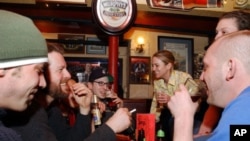New studies link student binge drinking to brain damage and drunken blackouts to higher rates of injury.
The National Institute on Drug Abuse reports that 42 percent of American college students engage in what’s known as “binge” drinking.
Tim McQueeny, a doctoral student in the Psychology Department at the University of Cincinnati says scientists are taking notice, and for good reason.
“The peak years of alcohol use are during the years when the brain is still developing, especially 18 to 25 when substance use, such as binge drinking, is most prevalent," he says. "That’s four drinks for girls and five or more for guys.”
Effects on the brain
McQueeny and his advisor, assistant professor Krista Lisdahl Medina, are especially interested in how binge drinking affects the brain during this critical period of development.
“We looked at a very high-resolution picture of the brain, where we can actually measure what’s called cortical thickness," says Lisdahl Medina. "So this is a measure of basically how thick their brain matter is.”
They found that binge-drinking was linked to a thinning of the pre-frontal cortex, a region of the brain with a long list of critical functions including: decision making, controlling attention, the ability to inhibit responses, considering consequences, monitoring one's environment, acting appropriately and inhibiting impulses.
Blackouts and injuries
Another team of U.S. and Canadian scientists is also trying to measure the health consequences of student binge drinking.
Dr. Michael Fleming's team, from Chicago's Feinburg School of Medicine, monitored the occurrence of alcohol-induced blackouts and drinking-related injuries among almost 1,000 students at five universities over a two-year period.
“A blackout is a true period of amnesia, it’s a transient acute memory loss that can last from a couple hours to longer, depending on how much you drank," says Fleming. "So, we wanted to know whether that put students, in particular college students, at higher risk for injury.”
They found that it did. According to Fleming, one in four students accidentally harmed themselves while drinking. And as the number of blackouts rose, so did the rate of physical injuries.
Other studies support these findings. A national comprehensive study found that, in 2001, almost 600,000 college students were injured as a result of alcohol use.
Intervention
Some universities are stepping up efforts to combat the problem.
Amanda Long, coordinator of Campus Alcohol Programs at the University of Maryland, works to ensure students understand the risks and consequences of alcohol abuse before they even set foot on campus as freshmen.
“We start off by asking them to complete a national three-hour long educational program," says Long. "It is really just a look at alcohol, how it affects students, how it can be a detriment to their progression as a student.”
Once they’re on campus, students continue to get support. Long speaks at freshman orientation, resident advisor training and at events designed to engage high-risk student groups, such as athletic clubs, fraternities and sororities.
At some schools around the country, students are now required to access online alcohol intervention resources such as eCHECKUP TO GO, a service administered by San Diego State University in California.
“The program gives the student a personalized feedback about their use of alcohol," says project director Doug Van Sickle, "and how it affects goals and aspirations that are important to them, career and life, relationships, self-esteem, health and fitness, those kinds of things.“
According to Van Sickle, the program doesn’t try to scare students with grim statistics about alcohol-induced brain damage or student deaths.
Instead, the idea is to give students numbers they can understand, like how many calories they consume and how much money they spend during a night out drinking.
International universities are also taking note. According to San Diego State University, the eCHECKUP TO GO online program is now being used on 500 college campuses worldwide.







